The Null Device
2006/4/19
Sydney-based electronic music magazine Cyclic Defrost has a profile of Steve Law, the Melbourne electronic musician best known for 1990s ambient-trance act Zen Paradox:
'[Melbourne] has developed enormously over the past ten years or so,', Law assesses of the city's electronic-attuned independent music scene. 'More experimental and improvised music has been flourishing in Melbourne over the past few years, with festivals like Liquid Architecture, What Is Music? and Anthony Pateras and Robin Fox's excellent Articulating Space events - as well as regular nights like Make It Up Club. It's a great city — I'm not sure why, but there has always been a great artistic vibe here.'
There have been drawbacks, however. 'Ten years ago there was a ton of techno happening, but very little on the electronic improv/experimental scene. Unfortunately the live techno scene itself is not as healthy as it was. Lately at the bigger parties — and in clubs — things have gotten a lot more commercial, and that doesn't leave much room for live performers who are pushing their own unique sound.' The result has been that, while Steve Law has no problem finding more abstract electro gigs for himself, there's been a dearth of opportunities for Zen Paradox...
He does, however, perceive another emergent problem. 'I think the biggest development, not necessarily a good one, has been the gentrification of electronic music. Back at the beginning of the 90s it was simply "techno" or electronic music, but since then a huge number of sub-genres have developed, each with their own dedicated following. I think this tends to fragment the scene quite a bit, and unfortunately people have a blinkered approach towards any music outside of the particular sound they're into.'
A package just arrived in the mail, containing a Buddha Machine.
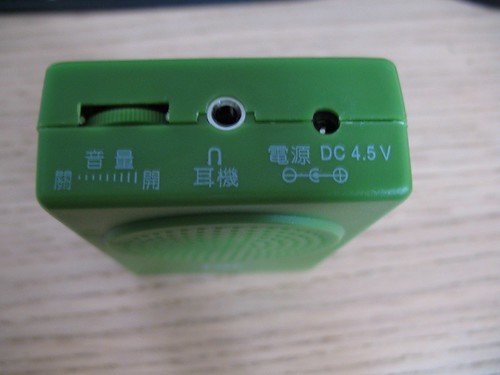
For those not familiar with the Buddha Machine, it is a small plastic device, about the size and shape of an old-fashioned transistor radio, which plays several loops of what sounds like minimal electronic ambient music, through a built-in speaker or headphones. It was designed by two artists from Beijing's electronic-music underground, Christiaan Virant and Zhang Jian.
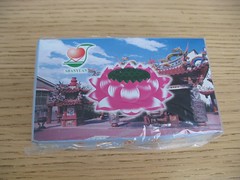
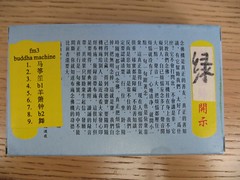
Built in Chinese factories (though what isn't these days?), the Buddha Machine proudly embodies a made-in-China commodity-gadget aesthetic. It comes in a box decorated with lotus flowers, Buddhist swastikas and a photograph of a temple, and looking more like it would hold patent medicines than consumer electronics. The box contained two AA batteries (designed to resemble Duracells, only more cheap-looking) and device itself. The device made of thick plastic, its pieces fitting together slightly roughly (no iPod sheen here), and all the labels are exclusively in Chinese, with the exception of the creators' URL on the bottom. The Buddha Machine comes in six colours, though there is no means of choosing one; they are distributed at random, and which you get is the luck of the draw. Mine was green.
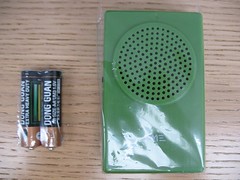
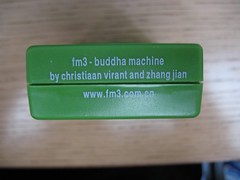
When switched on, the device plays a randomly-chosen loop through its speaker or the headphones. It has a small, ordinary-looking switch on the side; when this is flipped, it changes the loop to a different randomly-selected one. (It has 9 built in.) The loops come from performances by the two artists, and are stored in memory on the device. They sound, in a word, ambient, varying from glitchy, saturated chords and slowed-down instrument sounds to minimalistic micromelodies played on a variety of lo-fi drones and distorted string-like instruments, to what sound like fragments of larger works, chopped out of their context and fashioned into textures. The loops are chosen at random; flicking the rather ordinary-looking switch on the side of the unit switches to another loop. It is probably a cliché to describe it as "oddly soothing", though the effect is.
And here is an interview with the creators, describing how they came up with the idea, and how surprised they were to sell as many as they have; they had expected to sell a few hundred, but then various bloggers and hipsters (notably Pitchfork Magazine) picked the Buddha Machine out as a techno-fetish object to file alongside their Lomo ActionSamplers.
The next thing after digital rights management (DRM) may be attention rights management (ARM), which ensures that advertisers get the eyeballs they have paid good money for. Already, the signs are there: Philips have filed for a patent on a broadcast flag to prevent viewers from skipping ads. And don't try channel-surfing either, as that's blocked as well:
Philips suggests adding flags to commercial breaks to stop a viewer from changing channels until the adverts are over. The flags could also be recognised by digital video recorders, which would then disable the fast forward control while the ads are playing.
The patent also suggests that the system could offer viewers the chance to pay a fee interactively to go back to skipping adverts.Of course, you can still get up and go to the kitchen to grab a snack. Perhaps the next generation will have set-top boxes capable of counting viewers with an infrared camera, and getting petulant (or charging an "ad-skipping fee" to the subscriber's account) if people leave during the ads?
Philips' patent acknowledges that this may be "greatly resented by viewers" who could initially think their equipment has gone wrong.They don't say...
What do you do if you're a multinational corporation ranked among the 10 most "unethical" firms in global public opinion, and wish to rehabilitate your image? Well, if you're Nestlé (of baby-milk infamy), you buy up ethically sound brands like the Body Shop and the Linda McCartney food range.